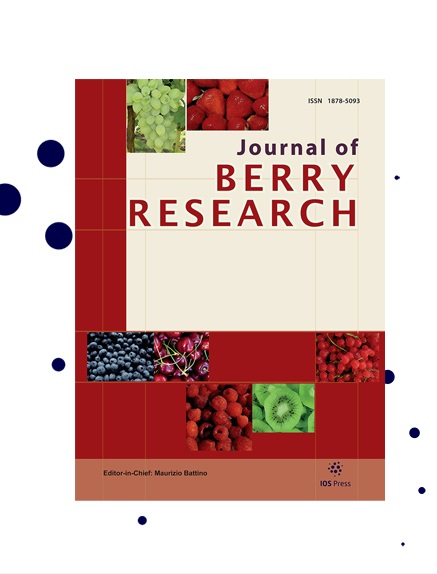高丛蓝莓的糖积累和相关基因表达因品种、成熟期和贮藏温度而异
IF 1.4
4区 农林科学
Q3 PLANT SCIENCES
引用次数: 3
摘要
背景:高丛蓝莓的甜度是消费者的感官质量标准。代谢产物和相关基因表达的变化导致蓝莓感官品质的变化。目的:通过测定蓝莓采收前后有机酸、糖含量的变化,以及β淀粉酶、转化酶、蔗糖磷酸合酶、叶绿体单糖转运蛋白等与糖积累相关基因的表达水平,探讨蓝莓的成熟机制。方法:采用随机完全区组设计,采用杜克、塞拉和伊丽莎白三种不同的蓝莓品种,在两个成熟阶段收获,然后在室温或4°C中保存7天。HPLC法测定有机酸和糖含量,qPCR法分析基因表达水平。结果:品种、成熟期和贮藏条件影响蓝莓糖的合成和有机酸的降解,从而决定蓝莓的甜度,并对代谢机制相关的标记基因表达和化合物进行分析。结论:研究结果揭示了葡萄成熟和采后品质的机理。本研究为蓝莓品种的选择提供了依据。本文章由计算机程序翻译,如有差异,请以英文原文为准。
Accumulation of sugars and associated gene expression in highbush blueberries differ by cultivar, ripening stage, and storage temperature
BACKGROUND: The sweetness of highbush blueberries is a sensory quality standard for consumers. Changes in metabolites and expression of associated genes induce variation in the sensory quality of blueberries. OBJECTIVE: This work investigated the ripening mechanism of blueberries by measuring changes in organic acids and sugar content as well as the gene expression levels associated with sugar accumulation, such as β amylase, invertase, sucrose phosphate synthase, and tonoplast monosaccharide transporter genes, before and after harvesting. METHODS: We used three different blueberry cultivars (Duke, Sierra, and Elizabeth) that we harvested at two ripening stages in a randomized complete block design and then kept at room temperature or 4°C for 7 days. The organic acids and sugar content were measured via HPLC, and gene expression levels were analyzed by qPCR. RESULTS: Cultivars, ripening stage, and storage conditions affected the synthesis of sugars and degradation of organic acids to determine the sweetness in blueberries and the expression of tagged genes and analyses of compounds involved in the metabolic mechanism. CONCLUSIONS: The results provide insights into the mechanism underlying the ripening and the postharvest quality. This study may support the selection of suitable blueberry cultivars that meet customer demand.
求助全文
通过发布文献求助,成功后即可免费获取论文全文。
去求助
来源期刊

Journal of Berry Research
Biochemistry, Genetics and Molecular Biology-Biochemistry
CiteScore
3.50
自引率
11.80%
发文量
21
期刊介绍:
The main objective of the Journal of Berry Research is to improve the knowledge about quality and production of berries to benefit health of the consumers and maintain profitable production using sustainable systems. The objective will be achieved by focusing on four main areas of research and development:
From genetics to variety evaluation
Nursery production systems and plant quality control
Plant physiology, biochemistry and molecular biology, as well as cultural management
Health for the consumer: components and factors affecting berries'' nutritional value
Specifically, the journal will cover berries (strawberry, raspberry, blackberry, blueberry, cranberry currants, etc.), as well as grapes and small soft fruit in general (e.g., kiwi fruit). It will publish research results covering all areas of plant breeding, including plant genetics, genomics, functional genomics, proteomics and metabolomics, plant physiology, plant pathology and plant development, as well as results dealing with the chemistry and biochemistry of bioactive compounds contained in such fruits and their possible role in human health. Contributions detailing possible pharmacological, medical or therapeutic use or dietary significance will be welcomed in addition to studies regarding biosafety issues of genetically modified plants.
 求助内容:
求助内容: 应助结果提醒方式:
应助结果提醒方式:


